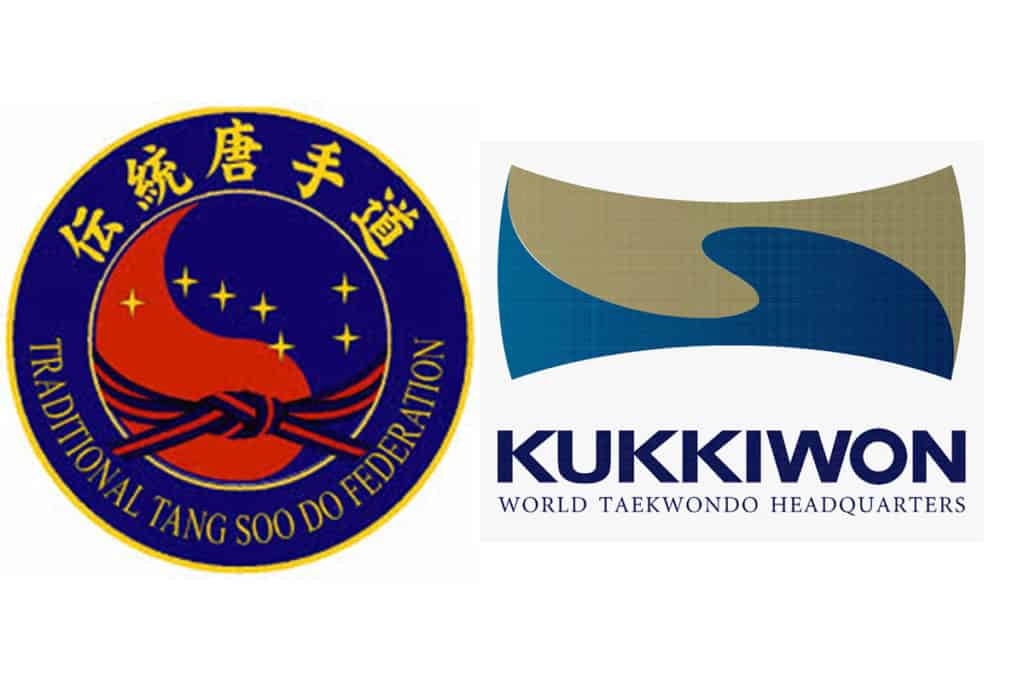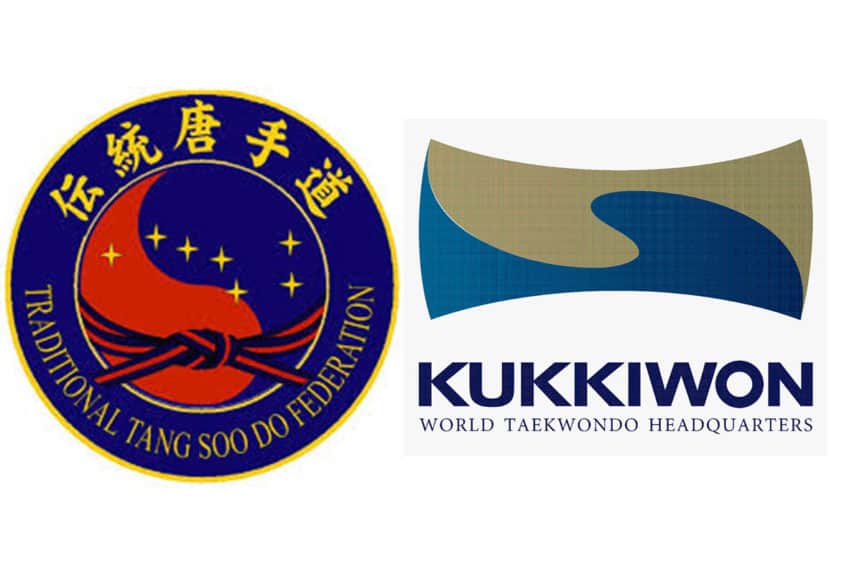
The Korean martial arts of TaeKwondo and Tang Soo Do have so much in common, while also having some key differences. Both were created out of turmoil in Korea and later became highly organized martial arts that are practiced by millions.
So what is the difference between Taekwondo and Tang Soo Do? Tang Soo Do is a Korean form of Japanese Shotokan Karate.It balances kicking and punching and uses the hips for more powerful kicks. TaeKwonDo comes from the older Korean form Taekkyon and uses more kicks and generates its power through a combination of speed and accuracy.
Keep reading below as we compare and detail similarities and differences between two of the most practiced Korean martial arts in the world.
Origin of TaeKwondo
Let’s start by re-detailing the origin story of TaeKwondo and then going into the origin of Tang Soo Do after. TaeKwondo is still a fairly young martial art that was formed in 1945 after the end of Japanese colonialism in Korea.
The techniques of TaeKwondo are not new as they were derived from ancient Korean martial arts. Predominantly Taekkyon, which was also an old Korean game that consisted of all kicks.
TaeKwondo was created to preserve the ancient Korean martial arts that were nearly forgotten due to centuries of foreign nations occupying Korea. Particularly the last occupation with Japan, who wanted to erase Korean history and establish their culture in Japan.
In 1945 after Japanese colonialism ended many kwans(martial arts schools) started to open teaching traditional Korean martial arts. The instructors of these kwans wanted to create an organized martial art with a curriculum derived from each style that they would all acknowledge.
One of the people was General Choi Hong-hi, who is considered by many as one of the founders of TaeKwondo. After he convinced the then South Korean president to see a demonstration.
This demonstration was the spark that TaeKwondo needed to become the widely practiced martial art it is today. After this demonstration, TaeKwondo became the official martial art of the South Korean military and later the entire nation.
Governing bodies like World TaeKwondo and the ITF(International TaeKwondo Federation) were formed decades later and a world championship was created for the martial art. After that, TaeKwondo became an official Olympic sport and today is practiced by millions of people across the world.
Origin of Tang Soo Do
Tang Soo Do(also known as Dang Soo Do) shares a similar origin story to that of TaeKwondo. It was also created during the end of Japanese colonialism in Korea. The martial art is a mix of Korean martial arts like TaeKwondo(Taekkyon and Subak), also including Shotokan Karate and a form of Kung Fu.
The founder of Tang Soo Do is a man by the name of Hwang Kee. He was a master of Subak and Taekkyon.
Kee secretly taught Subak during the Japanese colonial period in Korea, when the practice of Korean martial arts was banned by the local Japanese General. He caught the attention of the Japanese secret police and was forced to flee and walked to Manchuria. There he worked as a railroad worker and saw his country had become a lawless land on path of destruction, so Kee decided to enter China.
The story goes that he made his escape by climbing over the Great Wall of China, where he took refuge in the country. At this time in China it was hard to find martial arts teacher that would teach new students, but Kee found a Kung Fu mast named Master Yang and taught Kee his form of Kung Fu.
Master Yang’s form of Kung Fu called Yang Kung Fu was a stronger and more passive form of Kung Fu that was different that the southern style of Kung Fu that was more close quarters combat. After WWII ended, Kee would make his way back to Korea.
In 1945, the original kwans that taught Korean Martial arts wanted to create a unified style and curriculum. These are the same kwans that helped create TaeKwondo and also helped create the foundations for Tang Soo Do. During the organization of TaeKwondo, Master Kee and others that practiced Moo Duk Kwan(school name) felt the TaeKwondo movement was overshadowing their styles.
Tang Soo Do continued to develop its own style and carved its niche in the world.
The expansion of Tang Soo Do in the west was due to martial artist and actor Chuck Norris practicing the martial arts and later making an offshoot called Chun Kuk Do. Other offshoots were made such as American Tang Soo Do, and Kajukebo, which still spread the teachings of Tang Soo Do today.
The Main Similarities
Both martial arts Taekwondo and Tang Soo Do have many similarities between each other. Here are a few of the bigger similarities.
Creation
Both were created from the attempt to create a unified Korean martial art. Although due to politics and infighting, the kwans went their separate ways and created their own styles.
Techniques
TaeKwondo and Tang Soo Do share similar techniques. Particularly in kicks. Both use powerful rear leg and spinning kicks in their respective martial arts.
One Step Sparring
Both martial arts do one step sparring in their curriculums. Self defense demonstrations, where a counter is done in one step.
Philosophies of TaeKwondo and Tang Soo Do

Since both martial arts were created at the same time and place, their philosophies are very similar. Both teach principles that go beyond just the practice of the martial arts.
You aren’t just taught lessons about the martial arts, you are taught lessons about life. In life, you conduct yourself the same way you do in the martial arts school with respect, dignity, and be a virtuous person.
Living a good life and helping others are the foundations of TaeKwondo and Tang Soo Do.
Techniques of TaeKwondo and Tang Soo Do
Both martial arts derive a lot of their technique from Taekkyon with many different types of kicking attacks included in the martial art. What sets them apart mainly is the Karate influence in Tang Soo Do.
There are for hand strikes in Tang Soo Do, where TaeKwondo uses mostly long range attacks with kicks.
Weapons Training
As stated in other posts, there is no weapons training for traditional TaeKwondo. It is purely for hand to hand combat.
Tang Soo Do does however have weapons training in its teachings. Most notably, a long bo or staff that is called a bong that is used in Tang Soo Do weapons training.
Ranking System of Tang Soo Do
The ranking system of Tang Soo Do is also slightly different than in Ranking System of TaeKwondo. Tang Soo Do uses the Judo belt system with a little twist. In many schools instead of a black belt to signify to rank, the top color belt is dark blue.
The reason being in Tang Soo Do, the color black in Korean culture signifies you’ve completed the journey, but dark blue signifies your martial arts journey continues.
The dans of a black in Rang Soo Do each have a different name.
- 1st Dan: Cho Dan
- 2nd Dan: Ee Dan
- 3rd Dan: Sam Dan
- 4th and up to 9th Dan: Kodanja
To get to each dan, a Tang Soo Do practitioner is required to train the number of years to the next degree. Similar to how a practitioner in TaeKwondo must train to reach the next dan level.
Forms of TaeKwondo
As stated in other posts, there are generally 24-30 forms taught in TaeKwondo within the top organizations. ITF uses 24 forms, Global TaeKwondo added 6 to the original 24, and World TaeKwondo trains for sport competition rather than forms.
Forms of Tang Soo Do
In Tang Soo Do, they call the forms “hyung” and they vary depending on the federation. They are more like demonstrations of self defense taken from the Shotokan Karate. The martial art generally has 9 forms in the curriculum of a Tang Soo Do school and the hyungs are listed below.
Kee Cho
This form is taught in Tang Soo Do and was created by Gichin Funakoshi.
Pyung Ahn
This series was adopted from Okinawan and Japanese Karate and were called Pinan/Helan. The creator was Yasutsune Itosu, who taught Funakoshi that created the Kee Cho patterns.
Bassai
This form was also taken from Karate, where it was called Passai/Bassai and was created by Okinawan Bushi Sokon Matsumura.
Federations of TaeKwondo and Tang Soo Do
Here are the federations of TaeKwondo and Tang Soo Do. Some of the TaeKwondo federations recognize the belts of Tang Soo Do practitioners.
Top TaeKwondo Federations:
- World TaeKwondo Federation or World TaeKwondo(WTD or WT)
- International TaeKwondo Federation(ITF)
- American TaeKwondo Association(ATA)
Tang Soo Do Federation:
Competition and Sparring
TaeKwondo
In sport TaeKwondo, the matches are three two minute rounds, where you can land punches and kicks to the body and sometimes the head. Olympic competition allows light hand strikes to the head, but predominantly kicks are thrown in these competitions.
Tang Soo Do
In Tang Soo Do, they do a type of American style point sparring, but with a Tang Soo Do twist. The rounds are also 2 minutes, but it is the best to 3 points to win, so competitors are more strategic to land their points. To get credit for landing strikes in Tang Soo Do point sparring, you must do with force, but not too much as to not KO your opponent.
Real Life Effectiveness
It really is unfair to compare, which martial art is better in real life effectiveness. They both come from the same place and cross training between the two is common. Although, there are a few key differences.
Tang Soo Do has an edge in having weapons training in its system, but that is really it. It would be a toss up in a match since both share similar techniques and both are good for self defense.
One thing that is certain and that is both would be great martial arts to learn from. The techniques are good and you will be a better and healthier person from training in them.

